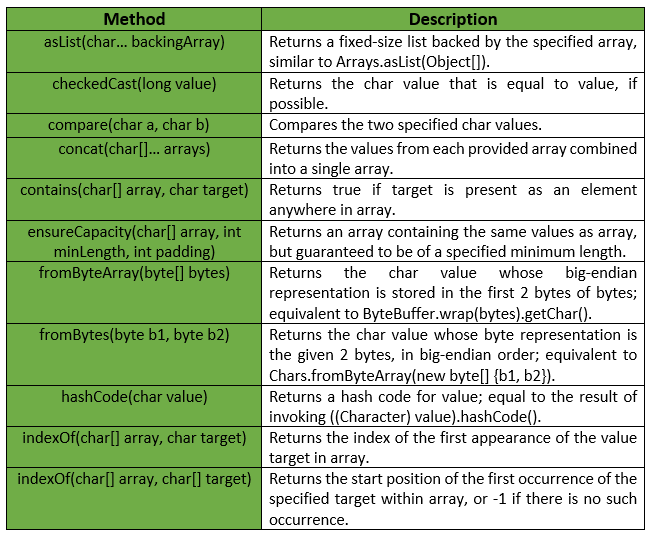字符类 |番石榴 |Java
Chars是原始类型 char 的实用程序类。它提供了与 char 原语有关的静态实用方法,这些方法在字符或数组中都没有。此类中的所有操作都严格按数字处理 char 值,即它们既不支持 Unicode,也不依赖于语言环境。
宣言 :
@GwtCompatible(emulated=true)
public final class Chars
extends Object
下表显示了 Guava Chars Class 的字段摘要:

Guava Chars Class 提供的一些方法是: 
例外:
- checkedCast : IllegalArgumentException如果值大于字符.MAX_VALUE 或小于字符.MIN_VALUE
- min : IllegalArgumentException如果数组为空。
- max : IllegalArgumentException如果数组为空。
- fromByteArray : IllegalArgumentException如果 bytes 的元素少于 2 个。
- ensureCapacity : IllegalArgumentException如果 minLength 或 padding 为负数。
- toArray : NullPointerException如果集合或其任何元素为空。
下表显示了 Guava Chars Class 提供的一些其他方法: 
下面给出了一些示例,显示了 Guava Chars Class 方法的实现:
示例 1:
// Java code to show implementation
// of Guava Chars.asList() method
import com.google.common.primitives.Chars;
import java.util.*;
class GFG {
// Driver method
public static void main(String[] args)
{
char arr[] = { 'g', 'e', 'e', 'k', 's' };
// Using Chars.asList() method which
// converts array of primitives
// to array of objects
List myList = Chars.asList(arr);
// Displaying the elements
System.out.println(myList);
}
}
输出 :
[g, e, e, k, s]
示例 2:
// Java code to show implementation
// of Guava Chars.toArray() method
import com.google.common.primitives.Chars;
import java.util.*;
class GFG {
// Driver method
public static void main(String[] args)
{
List myList = Arrays.asList('g', 'e', 'e', 'k', 's');
// Using Chars.toArray() method which
// converts a List of Chars to an
// array of char
char[] arr = Chars.toArray(myList);
// Displaying the elements
System.out.println(Arrays.toString(arr));
}
}
输出 :
[g, e, e, k, s]
示例 3:
// Java code to show implementation
// of Guava Chars.concat() method
import com.google.common.primitives.Chars;
import java.util.*;
class GFG {
// Driver method
public static void main(String[] args)
{
char[] arr1 = { 'g', 'e', 'e' };
char[] arr2 = { 'k', 's' };
// Using Chars.concat() method which
// combines arrays from specified
// arrays into a single array
char[] arr = Chars.concat(arr1, arr2);
// Displaying the elements
System.out.println(Arrays.toString(arr));
}
}
输出 :
[g, e, e, k, s]
示例 4:
// Java code to show implementation
// of Guava Chars.contains() method
import com.google.common.primitives.Chars;
class GFG {
// Driver method
public static void main(String[] args)
{
char[] arr = { 'g', 'e', 'e', 'k', 's' };
// Using Chars.contains() method which
// checks if element is present in array
// or not
System.out.println(Chars.contains(arr, 'g'));
System.out.println(Chars.contains(arr, 'm'));
}
}
输出 :
true
false
示例 5:
// Java code to show implementation
// of Guava Chars.min() method
import com.google.common.primitives.Chars;
class GFG {
// Driver method
public static void main(String[] args)
{
char[] arr = { 'g', 'e', 'e', 'k', 's' };
// Using Chars.min() method
System.out.println(Chars.min(arr));
}
}
输出 :
e
示例 6:
// Java code to show implementation
// of Guava Chars.max() method
import com.google.common.primitives.Chars;
class GFG {
// Driver method
public static void main(String[] args)
{
char[] arr = { 'g', 'e', 'e', 'k', 's' };
// Using Chars.max() method
System.out.println(Chars.max(arr));
}
}
输出 :
s